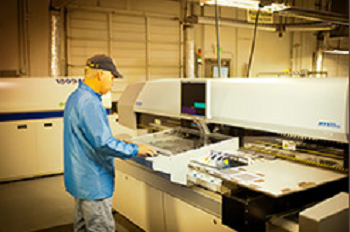
Whether designing a competitive commercial product or a high-end aerospace or medical product, creating working prototypes is an essential step in the design process. Effective prototyping not only grants engineers a method of testing theoretical designs (in order to verify that everything is in order) prior to production, but also creates a debugging platform to help resolve any issues that crop up.
When it comes to new electronic products, building the printed circuit boards assemblies (PCBAs) is a critical aspect of the development process. However, it can be difficult, time consuming, and expensive, particularly for small companies without access to the appropriate assembly equipment. In contrast, rapid prototyping capabilities can help companies keep up with today’s fast-paced business environment by reducing the time spent on research and development.
When needing a low number of printed circuit board assembly (PCBA) prototypes, hand-assembly may seem like the less expensive option but, in fact, it is very time-consuming and often a major inconvenience compared to using a low-volume assembly plant. Consider that it takes a designer approximately 15 hours to find and order all the components needed for the average assembly job. Obtaining the necessary components for just a few boards can be extra challenging because distributors tend to sell in bulk, meaning you may end up with a huge order of components when you only need a handful.
Furthermore, hand-assembly is reliant on human motor skills. It lacks machine-level precision and therefore is significantly more error-prone than machine automation especially on today’s fine pitch surface-mount technology. Botching an assembly job because of human-error only amounts to more wasted time and money, and makes it very difficult to debug the end result if the error source is unknown.
Another nightmarish aspect of hand-assembly is the inability to hand install lead-less, surface-mount components like BGA, LGA or QFN packages. Being limited on the type of components that can be used places a number of restrictions on a product’s design such as lower component density, single-sided board usage, and higher component cost to name a few.
Automated assembly services simplify the process by making PCB assembly easy and hassle-free; reputable assemblers such as Advanced Assembly specialize in building 1 to 35 boards within 1 to 5 days, drastically reducing processing time. Time saved on manual labor is time that may be reinvested on design revisions.
Streamlining the process a bit further, assemblers frequently assume responsibility over the logistical elements of ordering components ─ at the customer’s request. It is not uncommon for assemblers to have partnerships with multiple part and board vendors, eliminating the customer’s need to coordinate the purchase orders his or herself. Advanced Assembly even verifies a customer’s BOM and Gerber files to make sure the selected components properly fit before the order is made. Alternatively, customers have the option of ordering the components and/or boards themselves if they prefer a more hands-on approach.
The surface-mount technology used in automated assembly is a controlled manufacturing process; it not only produces more accurate results, but reduces board cost, material handling cost, and time. There’s a big convenience to be had in delegating the “dirty work” of PCB assembly to a third party, alleviating the headaches of what would otherwise be a nightmarish aspect of prototyping. Very often, the convenience earned translates to money saved and money made.
Advertisement
Learn more about Advanced Assembly





